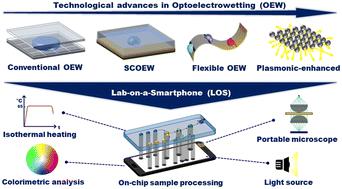Our official English website, www.x-mol.net, welcomes your
feedback! (Note: you will need to create a separate account there.)
A review of optoelectrowetting (OEW): from fundamentals to lab-on-a-smartphone (LOS) applications to environmental sensors
Lab on a Chip ( IF 6.1 ) Pub Date : 2022-07-25 , DOI: 10.1039/d2lc00372d Si Kuan Thio 1 , Sung-Yong Park 2
Lab on a Chip ( IF 6.1 ) Pub Date : 2022-07-25 , DOI: 10.1039/d2lc00372d Si Kuan Thio 1 , Sung-Yong Park 2
Affiliation

|
Electrowetting-on-dielectric (EWOD) has been extensively explored as an active-type technology for small-scale liquid handling due to its several unique advantages, including no requirement of mechanical components, low power consumption, and rapid response time. However, conventional EWOD devices are often accompanied with complex fabrication processes for patterning and wiring of 2D arrayed electrodes. Furthermore, their sandwich device configuration makes integration with other microfluidic components difficult. More recently, optoelectrowetting (OEW), a light-driven mechanism for effective droplet manipulation, has been proposed as an alternative approach to overcome these issues. By utilizing optical addressing on a photoconductive surface, OEW can dynamically control an electrowetting phenomenon without the need for complex control circuitry on a chip, while providing higher functionality and flexibility. Using commercially available spatial light modulators such as LCD displays and smartphones, millions of optical pixels are readily generated to modulate virtual electrodes for large-scale droplet manipulations in parallel on low-cost OEW devices. The benefits of the OEW mechanism have seen it being variously explored in its potential biological and biochemical applications. This review article presents the fundamentals of OEW, discusses its research progress and limitations, highlights various technological advances and innovations, and finally introduces the emergence of the OEW technology as portable smartphone-integrated environmental sensors.
中文翻译:

光电润湿 (OEW) 综述:从基础到智能手机实验室 (LOS) 应用再到环境传感器
电润湿(EWOD)作为一种用于小规模液体处理的主动型技术,由于其无需机械部件、低功耗和快速响应时间等独特优势,已被广泛探索。然而,传统的 EWOD 设备通常伴随着复杂的制造工艺,用于二维阵列电极的图案化和布线。此外,它们的夹层装置配置使得与其他微流体组件的集成变得困难。最近,光电润湿 (OEW) 是一种用于有效液滴操作的光驱动机制,已被提出作为克服这些问题的替代方法。通过在光电导表面上利用光学寻址,OEW 可以动态控制电润湿现象,而无需芯片上的复杂控制电路,同时提供更高的功能性和灵活性。使用商用空间光调制器(如 LCD 显示器和智能手机),可以轻松生成数百万个光学像素来调制虚拟电极,以在低成本 OEW 设备上并行进行大规模液滴操作。OEW 机制的好处已经看到它在其潜在的生物和生化应用中得到了各种探索。这篇综述文章介绍了 OEW 的基本原理,讨论了其研究进展和局限性,重点介绍了各种技术进步和创新,最后介绍了 OEW 技术作为便携式智能手机集成环境传感器的出现。同时提供更高的功能性和灵活性。使用商用空间光调制器(如 LCD 显示器和智能手机),可以轻松生成数百万个光学像素来调制虚拟电极,以在低成本 OEW 设备上并行进行大规模液滴操作。OEW 机制的好处已经看到它在其潜在的生物和生化应用中得到了各种探索。这篇综述文章介绍了 OEW 的基本原理,讨论了其研究进展和局限性,重点介绍了各种技术进步和创新,最后介绍了 OEW 技术作为便携式智能手机集成环境传感器的出现。同时提供更高的功能性和灵活性。使用商用空间光调制器(如 LCD 显示器和智能手机),可以轻松生成数百万个光学像素来调制虚拟电极,以在低成本 OEW 设备上并行进行大规模液滴操作。OEW 机制的好处已经看到它在其潜在的生物和生化应用中得到了各种探索。这篇综述文章介绍了 OEW 的基本原理,讨论了其研究进展和局限性,重点介绍了各种技术进步和创新,最后介绍了 OEW 技术作为便携式智能手机集成环境传感器的出现。数百万个光学像素很容易生成,以调制虚拟电极,以在低成本 OEW 设备上并行进行大规模液滴操作。OEW 机制的好处已经看到它在其潜在的生物和生化应用中得到了各种探索。这篇综述文章介绍了 OEW 的基本原理,讨论了其研究进展和局限性,重点介绍了各种技术进步和创新,最后介绍了 OEW 技术作为便携式智能手机集成环境传感器的出现。数百万个光学像素很容易生成,以调制虚拟电极,以在低成本 OEW 设备上并行进行大规模液滴操作。OEW 机制的好处已经看到它在其潜在的生物和生化应用中得到了各种探索。这篇综述文章介绍了 OEW 的基本原理,讨论了其研究进展和局限性,重点介绍了各种技术进步和创新,最后介绍了 OEW 技术作为便携式智能手机集成环境传感器的出现。
更新日期:2022-07-25
中文翻译:

光电润湿 (OEW) 综述:从基础到智能手机实验室 (LOS) 应用再到环境传感器
电润湿(EWOD)作为一种用于小规模液体处理的主动型技术,由于其无需机械部件、低功耗和快速响应时间等独特优势,已被广泛探索。然而,传统的 EWOD 设备通常伴随着复杂的制造工艺,用于二维阵列电极的图案化和布线。此外,它们的夹层装置配置使得与其他微流体组件的集成变得困难。最近,光电润湿 (OEW) 是一种用于有效液滴操作的光驱动机制,已被提出作为克服这些问题的替代方法。通过在光电导表面上利用光学寻址,OEW 可以动态控制电润湿现象,而无需芯片上的复杂控制电路,同时提供更高的功能性和灵活性。使用商用空间光调制器(如 LCD 显示器和智能手机),可以轻松生成数百万个光学像素来调制虚拟电极,以在低成本 OEW 设备上并行进行大规模液滴操作。OEW 机制的好处已经看到它在其潜在的生物和生化应用中得到了各种探索。这篇综述文章介绍了 OEW 的基本原理,讨论了其研究进展和局限性,重点介绍了各种技术进步和创新,最后介绍了 OEW 技术作为便携式智能手机集成环境传感器的出现。同时提供更高的功能性和灵活性。使用商用空间光调制器(如 LCD 显示器和智能手机),可以轻松生成数百万个光学像素来调制虚拟电极,以在低成本 OEW 设备上并行进行大规模液滴操作。OEW 机制的好处已经看到它在其潜在的生物和生化应用中得到了各种探索。这篇综述文章介绍了 OEW 的基本原理,讨论了其研究进展和局限性,重点介绍了各种技术进步和创新,最后介绍了 OEW 技术作为便携式智能手机集成环境传感器的出现。同时提供更高的功能性和灵活性。使用商用空间光调制器(如 LCD 显示器和智能手机),可以轻松生成数百万个光学像素来调制虚拟电极,以在低成本 OEW 设备上并行进行大规模液滴操作。OEW 机制的好处已经看到它在其潜在的生物和生化应用中得到了各种探索。这篇综述文章介绍了 OEW 的基本原理,讨论了其研究进展和局限性,重点介绍了各种技术进步和创新,最后介绍了 OEW 技术作为便携式智能手机集成环境传感器的出现。数百万个光学像素很容易生成,以调制虚拟电极,以在低成本 OEW 设备上并行进行大规模液滴操作。OEW 机制的好处已经看到它在其潜在的生物和生化应用中得到了各种探索。这篇综述文章介绍了 OEW 的基本原理,讨论了其研究进展和局限性,重点介绍了各种技术进步和创新,最后介绍了 OEW 技术作为便携式智能手机集成环境传感器的出现。数百万个光学像素很容易生成,以调制虚拟电极,以在低成本 OEW 设备上并行进行大规模液滴操作。OEW 机制的好处已经看到它在其潜在的生物和生化应用中得到了各种探索。这篇综述文章介绍了 OEW 的基本原理,讨论了其研究进展和局限性,重点介绍了各种技术进步和创新,最后介绍了 OEW 技术作为便携式智能手机集成环境传感器的出现。











































 京公网安备 11010802027423号
京公网安备 11010802027423号